soziale stadt - bundestransferstelle
besonderem Entwicklungsbedarf - Soziale Stadt"
Bremen Gröpelingen |
|||||||
|
Thomas Franke |
|||||||
The city-state of Bremen is implementing the "Socially Integrative City" programme in the context of its municipal programme "Living in Neighbourhoods (Wohnen in Nachbarschaften - WiN) - Developing Urban Districts for the Future," which was launched in 1999. The concept of the "WiN" programme shows many fundamental parallels to the "Socially Integrative City" programme in objectives, resource bundling, organisational structures, activation, and participation, so that the two development strategies have been combined in the Bremen approach "WiN/Socially Integrative City." "WiN" funds are used primarily for non-investment purposes and funds from the "Socially Integrative City" programme for investment projects.
1. Nature of the area 
The model area Gröpelingen, consisting of the three suburbs Lindenhof, Ohlenhof, and Gröpelingen, lies in western Bremen. The area, with very heterogeneous settlement structures, is bordered on the south by old industrial shipyards, harbour areas, and the river Weser, on the north by a motorway, railway tracks, and agricultural and allotment land.
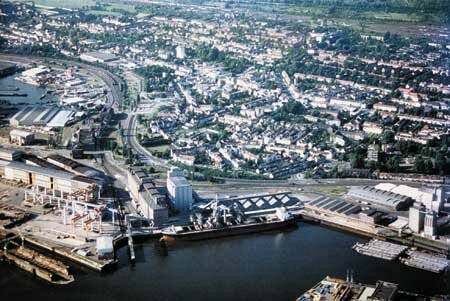 |
| Aerial picture of parts of the model area in the 1980s (Source: Bremische Gesellschaft für Stadterneuerung, Stadtentwicklung und Wohnungsbau mbH, Bremen) |
In the course of the 19th century, Gröpelingen grew to become an industrial suburb of Bremen with the development of the Weser port and the railway, and until very recently was a traditional working-class area. The end came with the closure of the AG Weser shipyard in 1983, which had been the biggest local employer. The closure cost more than 2,500 jobs.
During the Second World War, about 75% of the buildings in Gröpelingen were destroyed. The government subsidised apartment-block housing erected during post-war reconstruction now constitutes some 65% of the stock. Nevertheless there are still entire streets of the building type known as the "Bremen house" with a high proportion of home ownership.
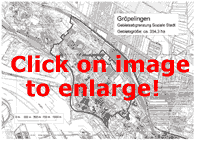 |
Boundaries of the model area "Gröpelingen" and the "focal area" (Source: Free Hanseatic City of Bremen, Senate Department for Building and Environment) |
Overall, industrial decline and the urban development "choices" of the post-war period produced considerable problems in Gröpelingen, from which the "district with special development needs" has still not fully recovered. Social, economic, ecological, and urban planning problems are concentrated in a few "problem islands," while other areas of Gröpelingen are comparatively intact, thanks not least of all to comprehensive rehabilitation measures and implementation of the EU Community Initiative URBAN.
2. Main Problems and Development Potential 
One of the main problems facing Gröpelingen is the extremely high unemployment rate: at 20.3% it is far higher than the 13.1% average for the whole of Bremen (excluding Bremerhaven). Insufficient training opportunities for young people and a lack of work close to home exacerbate the situation.
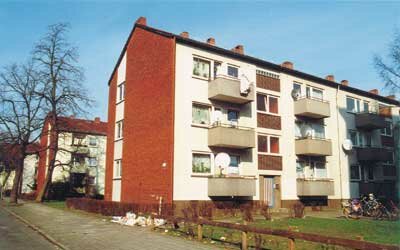 |
Apartment blocks in the "focal area" (Source: Ulrike Meyer, Berlin) |
And the number of people dependent on transfer payments is proportionally much higher in the model area than in the city as a whole. Gröpelingen has the highest proportion of social assistance dependence in Bremen; in 1999 some 16% of local residents were receiving regular transfers. The lack of purchasing power is a key cause of the gradual decline of the retail trade in Gröpelingen.
The socially worst deprived households are concentrated in certain areas in the north-east of the model area, which is cut off from the less problematic parts of Gröpelingen by a main thoroughfare. Up to 60% of the housing stock is reserved for low-income tenants, to which must be added 600 of the 1,000 dwellings in Bremen designated for the accommodation of the homeless. Social problems like alcoholism and most criminal offences registered in Gröpelingen are to be found in these "problem islands", where a trend towards neglect of both buildings and the residential environment is apparent.
Given the size and diversity of Gröpelingen, it is difficult to identify development potential for the entire model area. This is much easier for certain component areas.
Area structure potential: leaving aside the "problem islands" described, the model area has many comparatively intact locations, which can have a positive effect on adjoining neighbourhoods.
Urban development potential: the model area is close to the inner city, and can easily be accessed by both private and public transport. Inexpensive accommodation and small-scale urban development structures offer potential for the establishment of new households (students, young people). The high rate of owner-occupancy in the area provides the basis for residential stability and a positive identification with Gröpelingen.
Demography and Social Space
|
Gröpelingen |
Bremen |
|
|
Size |
354 ha |
40 428 ha |
|
Population (1999) |
25 445 |
540 330 |
|
Population decline (1995–1999) |
1.8 % |
1.6 % |
|
Average household size (2000) |
1.9 pers. |
1.92 pers. |
|
Number of dwellings (2000) |
13 389 |
281 204 |
|
Vacant dwelling units |
n.a. |
n.a. |
|
Housing benefit recipients |
n.a. |
n.a. |
|
Unemployment rate |
21.5 %(1) (1999) |
13.5 % (2000) |
|
Social assistance recipients (1999) |
15.8 % |
9.5 % |
|
Foreign population (2000) |
22.6 % |
12.5 % |
|
Population under 18 (1999) |
18.3 % |
16.5 % |
|
Population 60 and older (1999) |
36.5 % |
25.1 % |
|
(1) Unemployment figure |
||
Local economy potential: although there are complaints about the gradual decline of the (German-operated) retail trade and services, Gröpelingen also has a vital ethnic economy which appears to be counteracting this trend. Qualification and employment measures can be coupled with urban renewal, modernisation, and residential environment improvement measures in the model area.
Civic engagement/community/social infrastructure potential: despite differences in the social situation and ethnic origin of model area residents, many local actors describe them as very open, so that integration work to enhance community cohesion is still relatively successful here. The share of migrants in the model area is 22.6%, far higher than the average for the city as a whole (12.5%); to some extent there is a Turkish "parallel world" alongside the German world, but peaceful coexistence is the order of the day, so that there is potential for greater integration. There are many clubs, associations, organisations, and citizens' groups in Gröpelingen that promote the social life of the community.
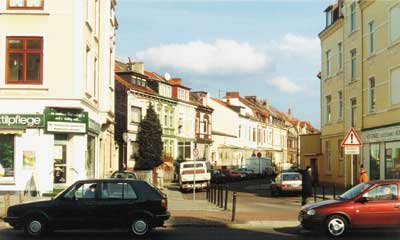 |
Small-scale development structures with a high proportion of owner-occupancy (Source: Ulrike Meyer, Berlin) |
Project and programme diversity: in Gröpelingen a wide range of development programmes and measures have been implemented in addition to the "WiN" and "Socially Integrative City" programmes, addressing almost all fields and areas (notably the EU Community Initiative URBAN, the "Immediate Action Programme Inner City and Subcentres," classical urban planning and housing development promotion).
3. Development Goals and Focal Points of Action 
Development goals for the present "Socially Integrative City" model area and for nine other Bremen and one Bremerhaven programme areas had already been set in 1998 under the action programme "Living in Neighbourhoods (WiN) - Developing Urban Districts for the Future." They included:
- improving housing and living conditions taking into account the specific requirements of particular target groups (young people, women);
- promoting and supporting engagement and the active participation of citizens in neighbourhood development in, for example, "local forums;"
- supporting cooperation between local and locally relevant actors;
- human and financial resource bundling to optimise utilisation.
- encouraging private investment.
These programme goals address six areas of action:
- housing stock and new construction,
- urban planning,
- economic effects and regional economy,
- education, qualification, and employment,
- community-related prevention and integration,
- social and cultural networks/promotion of personal initiative and self-organisation.
In late 2000 the Gröpelingen district advisory board decided to concentrate the utilisation of "WiN/Socially Integrative City" programme funds on the particularly disadvantaged "problem islands" in the north-east of the model area ("focal area"). The chief areas of action are to be:
- the redevelopment of simple housing and substitute structures,
- work on residential buildings/modernisation measures,
- changes in the occupancy policy and practice of housing associations,
- privatisation of multi-family/terrace housing,
- remedial measures in public open spaces, for pathways and green spaces,
- employment measures in the field of residential environment/job-creation measures,
- development of the social infrastructure,
- social integration of migrant families and disadvantaged German families,
- preventive facilities for young people.
4. Key Projects 
From among the wide range of projects and measures in the model area, those that are most closely in keeping with the "Socially Integrative City" programme objectives have been selected as key projects:
The projects JOB TREFF WEST at the Gröpelingen Youth Leisure Centre and RAZ-Mobil in West Bremen offer young people educational and training help and vocational guidance. The concrete measures on offer include care and guidance for young people until they leave school under the motto "Ran an die Zukunft - RAZ" ("Tackling the Future"), providing vocational guidance for school leavers, placement in practical training positions, qualification, training, and employment for young people, individual guidance and long-term support for individual young people, the coupling of counselling and support services with recreational activities, and social educational measures for young people with school and social problems. JOB-TREFF WEST and RAZ-Mobil cooperate closely with schools and businesses.
Assistance for citizens in preventing violence and for other local actors in conflictual situations is the aim of the project "Conciliation in Neighbourhoods." In January 2002 a conciliation agency offering low-threshold services in the "focal area" was set up as a contact point for people involved in conflicts; violence prevention campaigns in the "focal area" complement the project, which cooperates with other organisations in Gröpelingen.
In the Stuhmer Straße Community House operated by the Office for Social Services, a wide range of social services are provided at a central location. They include a public day centre for school children, social group work with children and young people, placing non-profit activities in the context of a "neighbourhood exchange," the provision of premises for meetings and discussions or the preparation and staging of festive events. Since January 2002 the local management office has also been accommodated here. The facilities provided by the Stuhmer Straße Community House are complemented by facilities available in the immediate vicinity - streetball court, supervised children's playground, and a petting zoo.
 |
Tenants paint the stairwell of their building (Source: Kay Borchers, Bremen) |
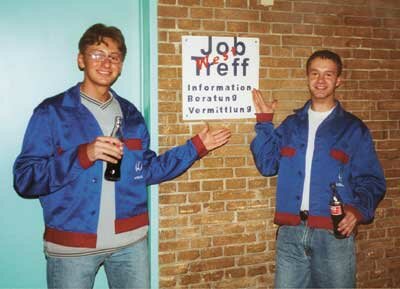 |
Job centre in the Gröpelingen Youth Leisure Centre (Source: Job-Treff West, Bremen) |
For a number of years now, one of the most important measures in the "focal area" has been the improvement of dwellings and the residential environment with far-reaching resident participation, and the promotion of personal initiative among local residents. In cooperation with the Office for Social Services and the Bremen Company for Urban Renewal, Urban Development, and Residential Construction, various identification-promoting measures are planned and implemented, like the joint landscape design of housing areas and children's playgrounds, greening campaigns, the renovation of stairwells and entrance areas, refuse disposal, and joint festivities.
5. Organisation and Management 
Because the "Socially Integrative City" programme has been integrated in the Bremen programme "Living in Neighbourhoods (WiN) - Developing Urban Districts for the Future," no new or supplementary organisational and management structures were established for implementing the "Socially Integrative City" programme. In Bremen, neighbourhood management generally takes place at a central level ("cross-authority working group") and a local level ("local management"). This organisational structure typical of the "WiN" programme has been deviated from in implementing the "Socially Integrative City" in the Gröpelingen model area, but since the beginning of 2002 the structures usually found in most "WiN" areas have been adopted.
Administrative Level
1. The two departments responsible for the "WiN" and "Socially Integrative City" programmes, Building and Environment and Work, Women, Health, Youth and Social Affairs have established a joint management under the heading "Living in Neighbourhoods (WiN)/Socially Integrative City" entrusted with managing, organising, and further developing the entire "WiN/Socially Integrative City" process. This includes checking project applications to see whether they meet programme requirements, controlling and monitoring the utilisation and outflow of funds, distributing resources according to a programme-term-related "area allocation" scheme, instructing and guiding "local management" staff in programme implementation, cross-authority programme documentation, and managing the cross-authority working group "WiN." The joint management also provides an information and contact point for local and locally operating actors.
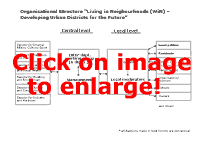 |
Organisational Structure "Living in Neighourhoods (WiN) - Developing Urban Districts for the Future" |
2. The cross-authority working group - composed of representatives from the two competent departments and from Internal Affairs, Culture, and Sport, Education and Science, Justice and the Constitution, Industry and Ports, and the Bremen Central Office for the Realisation of Equality for Women - votes on the project applications from the ten "WiN/Socially Integrative City" areas, awards grants from the "WiN/Socially Integrative City" programme in accordance with management proposals, and is thus the top steering institution for programme implementation.
3. Among other things, the steering group "WiN/Socially Integrative City" prepares draft documents on general policy and the steering function of the cross-authority working group.
Intermediary level
For neighbourhood management functions at the intermediary level between politics, administration, market, tertiary sector, and civil society, a "Citizens' Forum" was set up in Gröpelingen ("focal area") in January 2002 as in the other nine "WiN" areas under the direction of the local manager as an arena for discussion and participation.
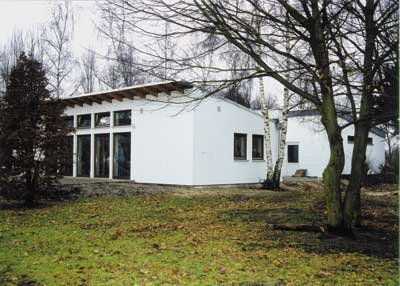 |
Contact point in the focal area - the Stuhmer Straße Community House (Source: Foto-Studio Penz GmbH, Bremen) |
Local Implementation Level
As far as programme implementation level is concerned, a range of social facilities and projects exists in the model area with its various neighbourhoods, none of which had until recently taken on local neighbourhood management functions. This changed in early 2002 with the setting up of the "local management," designed to intensify and mesh on-the-spot work, especially in the "focal area," and to bring together the various on-going support programmes at the implementation level.
6. Activation, Participation, and Public Relations 
Opportunities to participate had hitherto been offered the local population and other district actors primarily in the context of remedial measures and implementation of the EU Community Initiative URBAN in certain sub-areas of Gröpelingen. Participation therefore mainly had to do with projects and measures in fields clearly defined in terms of time and content. Furthermore, until the end of 2001, participation was possible almost only at the political level, i.e., by elected members of the district advisory board. Since January 2002, local forums have been organised in the "focal area" where local residents can, for example, discuss the allocation of WiN/Socially Integrative City funds.
Activation strategies target specific groups (girls, children and young people, school children, the unemployed) in individual measures and projects under different programmes - and thus limited in time and scope. Specific projects - for example in residential environment improvement - also seek the cooperation of certain groups in measures affecting their neighbourhood. However, it must be said in general that residents, especially migrants, are difficult to reach.
The action programme "We're for Gröpelingen" promotes community cohesion in the model area by making resources available with comparatively little red-tape for measures initiated by citizens. The programme is thus in the nature of a contingent fund, which, although existing in other Bremen "WiN" areas, has not been introduced in Gröpelingen.
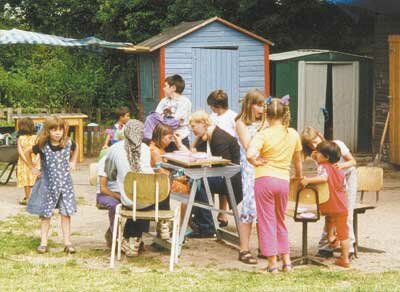 |
Children's party in the petting zoo (Source: Kay Borchers, Bremen) |
In the Gröpelingen model area there are many area-specific public relations approaches. An Internet site (www.groepelingen.de) and various district newspapers provide information on support programmes and project progress, events, advisory services, and local history, and on intercultural community life. A business directory present retailers, services, facilities, associations and clubs, and citizens' groups. With the help of an image campaign, which has been running for three years now under the motto "Gröpelingen's Going Places" a sense of community, of "corporate identity" has successfully developed, especially among retailers and service providers in the model area. However, no overall public relations concept specific to the model area has yet been elaborated.
7. Conclusion: "Gröpelingen's Going Places - Keep it Up!" 
Even before the "Socially Integrative City" programme started, a wide range of support structures had been developed in Gröpelingen and projects and measures successfully carried out. The designation of the particularly deprived "focal area" in the north-east of the model area can be regarded as a further stage of development.
Under the "WiN/Socially Integrative City" programme, objectives and areas of action for Gröpelingen have been determined, but there is currently no overarching, integrated plan of action developed with the collaboration of local and locally relevant actors, which could generate clearly defined development strategies for the model area, proposals for projects and measures, a financing plan, and the organisational and management structures needed for implementation. At present, the integrative aspect of the programme is based on guidelines drawn up for the municipal support programme "Living in Neighbourhoods (WiN) - Developing Urban Districts for the Future," covering six integrated areas of action, and on actor contacts, especially in managing the various locally relevant development programmes.
Organisational and management structures for implementing the WiN/Socially Integrative City programme have so far been strongly developed at the administrative level but weakly at the intermediary and local levels. Now that district advisory board meeting have been opened to the public and the range of issues dealt with extended, and with the establishment of a "local management" in the "focal area," it remains to be seen whether the organisational weight in district development shifts to the local implementation level. The local programme support team (Difu) believes that greater and, above all, more continuous local resident activation and participation require more opportunities for public participation to be made available, as is already the case in other Bremen "WiN" areas.
Model area public relations has many aspects, but could be improved. There is an overall lack of concerted public relations work for the WiN and Socially Integrative City programmes, which, for example, with multilingual flyers and posters, could draw attention more strongly to various local interests or give local actors more of a say. The intensive public relations which, although predominantly top-down, was undertaken in parts of the model area during regeneration work and implementation of the EU Community Initiative URBAN could serve as an example.
In the opinion of the local programme support team, identity-forming measures like the image campaign for local retailers and service providers should be extended to other circles of actors and local residents to entrench the favourable developments achieved to date more strongly in the internal and external image of the the area.
Im Auftrag des BMVBS vertreten durch das BBR. Zuletzt geändert am 25.05.2005